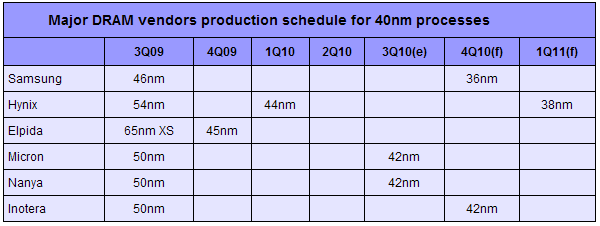Global DRAM supply will outgrow demand by about 3% in the last quarter of 2010 as major chipmakers ramp up their capacity using more advanced processes.
Forecasts that worldwide DRAM output will reach 425 million 1Gb-equivalent units in the fourth quarter, up from 380 million units in the third. However, demand will grow at a slower pace during the same period, rising to 412 million 1Gb-equivalent units from 382 million in the prior quarter.
Samsung Electronics and Hynix Semiconductor have ramped up their DRAM capacity using 40nm-class processes since early 2010, said analyst. Both will see their capacity grow through the last quarter of the year, thanks to improved yield rates for the sub-50nm technologies.
Samsung's DRAM output will advance to 150 million 1Gb-equivalent units in the fourth quarter, compared to 100 million units in the first quarter. Samsung took the lead in 50nm to 40nm technologies, moving its 46nm process to mass production in the third quarter of 2009.
Hynix has also been pushing to increase output of 1Gb chips using its 44nm process, adding that the vendor shifted half of its production to that node in the second quarter. Estimated Hynix' total DRAM capacity at 78.5 million 1Gb-equivalent units in the second quarter, and the figure will top 100 million in the fourth.
Elpida Memory may not convert half of its total chip production at its Hiroshima plant to its 45nm process until the end of 2010, but its shipments will still be buoyed by capacity support from subsidiary Rexchip Electronics. Rexchip, which now supplies about 70% of its total production to Elpida, is set to transfer all of its capacity (80,000 12-inch wafers a month) to the 45nm node around year-end.
Micron Technology and its DRAM partner Nanya Technology are gearing up to ramp chip production using 42nm in the third quarter of 2010. Capacity ramps at their joint venture Inotera Memories will also contribute to global DRAM output.
Inotera runs two 12-inch fabs with a combined capacity of 130,000 wafers a month. The JV will convert all of its chip production to 50nm by the end of 2010, and start pilot runs for chips using a 42nm process in September.
In addition, DDR3 shipments will continue to rise through the last quarter of 2010, and account for more than 70% of the global DRAM market. DDR3's share of the DRAM market grew to 51% in the second quarter, compared to 46% in the prior quarter and 14% in second-quarter 2009.

 |